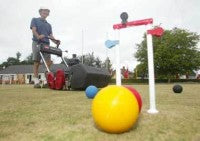The Mitsubishi Motors World Croquet Singles Championship
The Mitsubishi Motors World Croquet Singles Championship
By David Magee

The World Croquet Singles Championship came to a very successful conclusion on Sunday 14 August 2005. The croquet in the final match was of the highest standard and the winner, Reg Bamford of South Africa, produced an awesome display of skill to beat the defending champion, Robert Fulford of England, in three straight games. Many readers will not be familiar with the skill level of the top players but it is no exaggeration to compare Reg Bamford's performance with that of Roger Federer in this year's final of the Wimbledon Tennis Championship.
The final Sunday brought to a conclusion nine days of hard work preparing the courts for each day's play. It is many years since I rose with the sun and I had forgotten what a glorious time of day those early hours after sunrise can be. All eleven courts were mown each morning and we were fortunate to have the forbearance of our neighbours that allowed us to start our work before 6 am each day. This early start was necessitated by the need to have finished mowing in ample time to reset all the hoops on each court before the start of play at 9.30 am. Each of the six hoops on a court has to be set to a width of 1/32nd of an inch (0.8 mm) greater than the diameter of the croquet ball. As the ground got harder throughout the Championship this task was taking up to 30 minutes per court and the team of hoop-setters came under increasing pressure to maintain the accurate standards in the given timescale.
We were blessed with glorious weather during the Championship and the playing surface got progressively faster as it dried out in the baking sun. At the request of the Championship organisers we had stopped watering the grounds three days before the start of the Championship. Mid way through the second week I had become increasingly concerned about the lack of moisture in the soil and the potential risk of long-term damage to the grass.
Fortunately, fate was on my side and the three hours of gently falling rain in the middle of the second Saturday solv
Although a great honour for the Club, the World Championship has been something of a distraction to our efforts to improve the quality of our courts. I mentioned in my last article that we have embarked on a programme of rectification and improvement of the playing surface.
Now that we have achieved the first objective of regaining full grass cover on each court, we can start work on improving the quality of that cover by eradicating all the coarse grasses and building up the sward with fine turf grasses.
We also need to improve the levels of the more uneven courts by raising or filling in all the hollows. To that end I would be most interested to learn your reader's thoughts on whether or not our changing weather patterns of long dry spells followed by heavy rainfall is having an impact on sub-soil structure causing undulations in playing surfaces. Anyway, it will be some ten years before the Championship returns to this country and if Cheltenham is selected as the venue once again, I hope we will be able to offer flatter and even faster courts for the competitors.
For details about Cheltenham Croquet club you can visit their web site at www.croquet.org.uk/
